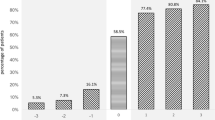Abstract
Background. The availability of newer, faster computed tomography (CT) technology has engendered discussion about whole-body CT-scanning for primary radiological diagnostics of seriously injured patients.
Method. Within a quality management system, the scaled, priority-oriented scheme of conventional radiological and CT-diagnostics used in each institution was analysed and compared with the possible benefit of whole-body CT-scanning. Every patient with severe trauma admitted directly from the scene of an accident, underwent basic radiological and sonographic diagnostics in the emergency room (ER). According to the findings, patients in a stable vital condition had CT-scans when indicated by the guidelines of the particular institution.
Results. From 5/1998 until 12/2000, a total of 832 patients were treated in the ER. Of those, 480 patients (average ISS 20) were admitted directly from the scene of the accident. Basic radiological – sonographic diagnostics (radiographs of cervical spine, chest, and abdomen, as well as abdominal sonography) took 15±8 min. Twenty-two (5%) of the patients in hemorrhagic shock needed emergency operations after 57±43 min. The remaining patients underwent further radiological diagnostics (spine, extremities etc.) after 44±27 min. In 79% (379) of patients, CT was indicated. Cranial CT for traumatic brain injury prevailed clearly with 74% of cases. Spine (24%), chest (18%), abdomen (5%) and pelvis (5%) were indicated comparatively less frequently. The incidence of delayed diagnoses (after ICU-admission) was 4% (22). In 2% (nine) of patients the lesions possibly could have been detected by a primary CT-scan. In the three cases with thoracic lesions, there was a deviation from the indication guidelines for thoracic CT as normally used in the institution. There were three cases of delayed diagnoses in both the cerebral (small contusion haematomas) region and the abdominal region. The abdominal lesions were detected by sonographic control examinations. No patient died because of a delayed diagnosis. The average X-ray dose was five times lower with the scaled diagnostic management comprising indicated CT when compared to the doses calculated for routine whole-body CT.
Conclusion. While 74% of patients had cranial CT, only 25% needed CT for the trunk regions. Delayed diagnoses were rare and without severe consequences for the patient. Considering the five times higher X-ray doses combined with the possible time loss in patients with unstable conditions, primary whole-body CT-scanning should not be performed routinely when serious injury is suspected.
Zusammenfassung
Hintergrund. Aufgrund neuerer Computertomographie- (CT-)Geräte wird die Ganzkörper-CT-Untersuchung als primäre Diagnostik schwer verletzter Patienten diskutiert.
Methode. Im Rahmen eines Qualitätsmanagementsystems wurde ein abgestufter, prioritätenorientierter Ablauf der konventionellen radiologischen und computertomographischen Diagnostik analysiert und dem möglichen Nutzen einer primären Ganzkörper-CT gegenübergestellt. Jeder Patient, der nach stumpfen Trauma primär vom Unfallort zuverlegt wurde, wurde im Schockraum einer radiologisch-sonographischen Basisdiagnostik unterzogen. Je nach Befund wurde nach klinikinternen Leitlinien die Indikation zur Computertomographie gestellt.
Ergebnisse. Von 5/1998 bis 12/2000 wurden 832 Patienten im Schockraum behandelt. Vom Unfallort wurden 480 Schwerverletzte (ISS 20) zuverlegt. Die Basisdiagnostik (Röntgen-HWS, -Thorax, -Becken und Abdomensonographie) erfolgte innerhalb von 15±8 min. Im Blutungsschock mussten 5% (22) der Patienten notfallmäßig nach 57±43 min operiert werden. Bei allen anderen erfolgte die weitere radiologische Diagnostik (Wirbelsäule etc.) nach 44±27 min. Bei 79% (379) wurde die Indikation zur Computertomographie gestellt. Die kraniale CT bei Schädel-Hirn-Trauma stand mit 74% der Patienten im Vordergrund. CT-Untersuchungen der Wirbelsäule (24%), des Thorax (18%), des Abdomens (5%) und des Beckens (5%) waren wesentlich seltener indiziert. Die Rate verzögert diagnostizierter Läsionen betrug 4% (22). Bei 2% (9) der Patienten hätten die Läsionen möglicherweise durch eine primäre CT diagnostiziert werden können. Bei den 3 Fällen mit thorakalen Läsionen wurde jeweils von den Diagnostikleitlinien abgewichen. Im Bereich des Schädels (kleine Kontusionen) fanden sich ebenso wie im Abdomen je 3 Fälle mit verzögerten diagnostizierten Verletzungen. Die abdominalen Läsionen konnten durch Kontrollsonographien aufgezeigt werden. Kein Patient verstarb aufgrund der verzögert diagnostizierten Läsionen. Die durchschnittliche Strahlenbelastung lag bei abgestuftem Diagnostikablauf um ein Fünffaches unter den Werten die bei routinemäßiger Ganzkörper-CT erreicht worden wären.
Schlussfolgerung. Im Gegensatz zum Schädel wurde die Indikation zur CT im Bereich des Rumpfes nur bei einem Viertel der Patienten gestellt. Verzögert diagnostizierte Läsionen waren trotzdem selten und ohne wesentliche Folgen. Aufgrund der erhöhten Strahlenbelastung und des möglichen Zeitverlusts bei instabilen Patienten sollte die primäre Ganzkörper-CT nicht routinemäßig bei allen Patienten mit Verdacht auf eine Mehrfachverletzung durchgeführt werden.
Similar content being viewed by others
Author information
Authors and Affiliations
Additional information
Priv.-Doz. Dr. S. Ruchholtz Klinik und Poliklinik für Unfallchirurgie, Universitätsklinikum Essen, Hufelandstraße 55, 45122 Essen, E-Mail: steffen.ruchholtz@uni-essen.de
Rights and permissions
About this article
Cite this article
Ruchholtz, S., Waydhas, C., Schroeder, T. et al. Stellenwert der Computertomographie in der frühen klinischen Behandlung schwer verletzter Patienten. Chirurg 73, 1005–1012 (2002). https://doi.org/10.1007/s00104-002-0429-1
Issue Date:
DOI: https://doi.org/10.1007/s00104-002-0429-1



